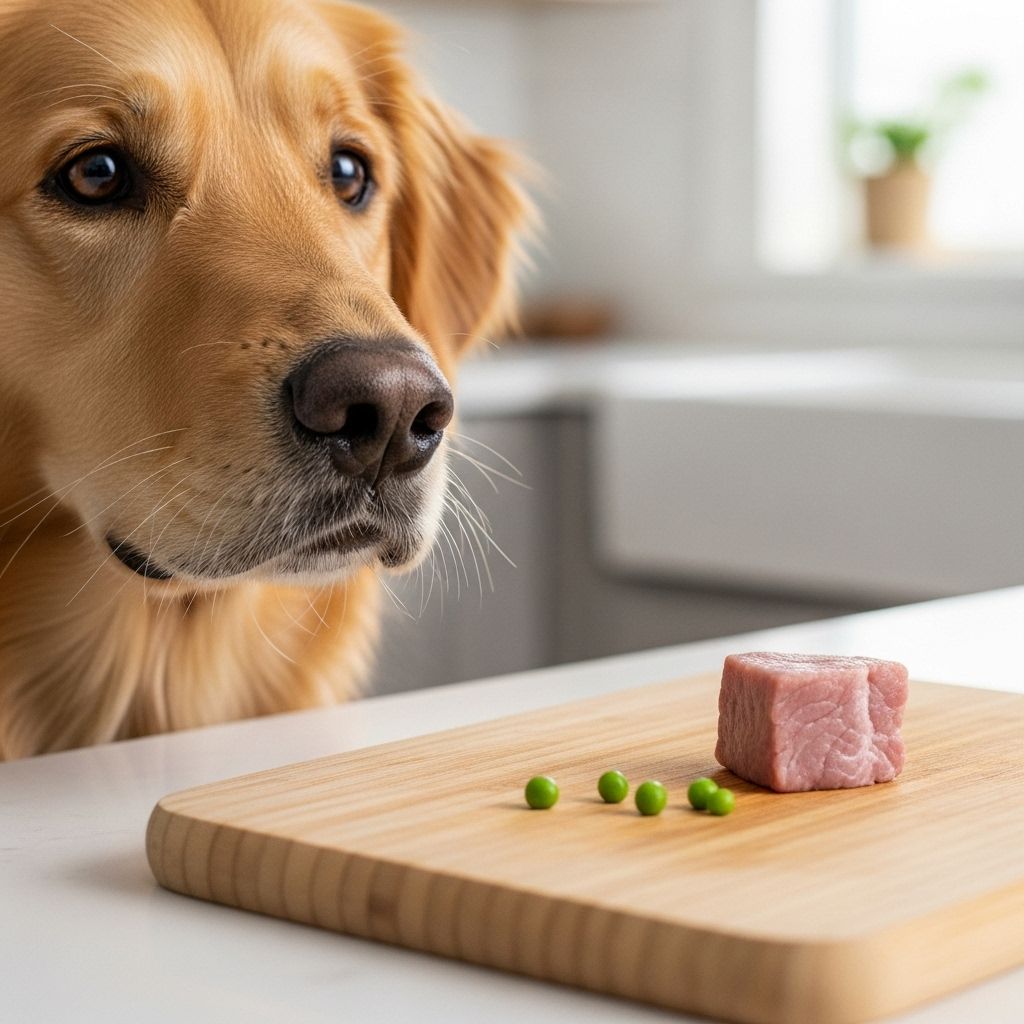Can Dogs Eat Pork? Risks, Benefits, and Guidelines
Understand the safety, benefits, and risks of feeding pork to dogs, with practical tips for keeping your dog healthy and happy.

Pet owners often wonder if pork is safe and healthy for their dogs. Pork is one of the most popular meats worldwide, but its suitability for dogs involves specific preparation requirements, possible health risks, and clear benefits. This article explores whether dogs can eat pork, how to serve it safely, and what pitfalls you should avoid.
Is Pork Safe for Dogs?
Plain, fully cooked pork can be a safe and flavorful treat for many dogs. However, preparation is crucial. Cook pork thoroughly without adding seasonings, sauces, or spices that can be harmful to dogs, such as garlic, onion, or high-salt rubs (source: AKC).
Raw or undercooked pork increases the risk of parasitic infections and should always be avoided (source: AKC).
- Cooked, unseasoned pork can be safe in small amounts.
- Never offer raw or undercooked pork due to parasite risks.
- Avoid processed pork products such as bacon, ham, and sausages.
Dangerous Additives to Avoid
Never feed dogs pork that is seasoned or cooked with the following ingredients, as they can be highly toxic to dogs:
- Garlic
- Onion
- Chives
- Paprika
- Sauces like barbecue sauce (high in salt, sugar, and sometimes toxic ingredients)
Can Dogs Eat Raw Pork?
No. Raw or undercooked pork is unsafe for dogs due to the risk of Trichinella spiralis larvae. This parasite causes an infection called trichinosis, which may lead to digestive problems, fever, muscle inflammation, lethargy, vomiting, diarrhea, and pain in dogs (source: AKC, Chewy). The risk is lower in dogs than humans, but symptoms are more severe in dogs with weak immune systems. Parasites and harmful bacteria are reliably killed only by thorough cooking.
Symptoms of Trichinosis in Dogs
- Vomiting
- Diarrhea
- Lethargy
- Fever
- Muscle pain and stiffness
If your dog ingests raw pork and shows any of these symptoms, consult your veterinarian immediately.
Nutritional Benefits of Pork for Dogs
When cooked properly and served plain, pork can offer several important nutritional benefits for dogs.
- High-quality protein: Pork provides the full range of essential amino acids, supporting muscle growth and repair (source: DogCancer, Chewy).
- B vitamins: Especially niacin (B3), B6, and B12, which are crucial for brain health and red blood cell production.
- Minerals: Important minerals in pork include iron, zinc, phosphorus, selenium, and potassium.
- Omega-6 Fatty Acids: Specifically linoleic acid, which helps maintain a healthy skin, coat, and immune function.
- Taste and palatability: Pork’s rich flavor makes it a high-value treat for many dogs, helping with training and motivation.
- Alternative protein source: Suitable for dogs allergic to chicken or beef (source: Chewy).
Table: Key Nutrients in Pork
| Nutrient | Role in Dog Health |
|---|---|
| Protein | Builds and repairs tissues; essential for enzymes and hormones |
| Niacin (B3) | Supports energy metabolism |
| Vitamin B6, B12 | Brain function, nerve health, red blood cell formation |
| Iron | Prevents anemia, carries oxygen |
| Zinc | Immune system support |
| Phosphorus | Healthy bones and teeth |
| Selenium | Antioxidant function |
| Linoleic acid (omega-6) | Skin/coat health, immune system |
Risks and Dangers of Feeding Pork to Dogs
Despite its benefits, pork carries risks if not served appropriately.
- Parasitic infections: Raw/undercooked pork can contain harmful parasites.
- Bone hazards: Never give your dog pork bones (raw or cooked). They can splinter, creating choking hazards or causing life-threatening digestive tract blockages (source: Chewy).
- Toxic seasonings and additives: Seasoned or marinated pork often contains harmful substances for dogs.
- Salt toxicity: Processed pork like bacon and ham have high salt content, which can lead to salt poisoning or kidney problems.
- Obesity risk: Pork is relatively fatty. Regularly feeding fatty pork can promote unhealthy weight gain, increasing the likelihood of heart disease and joint problems.
- Allergic reactions: While rare, some dogs may develop allergies or food intolerances to pork.
Common Pork Products: Can Your Dog Eat Them?
| Pork Product | Is it Safe? | Risks |
|---|---|---|
| Pork Chop (Plain, Cooked) | Yes, in moderation, unseasoned | Fat content, never serve bone |
| Pork Bones | No | Choking, digestive punctures/blockages |
| Bacon | No | Excess salt, fat, carcinogens |
| Ham | No | High salt, preservatives |
| Sausage | No | Spices, salt, fat, preservatives |
| Cooked, plain pork tenderloin | Yes, in small portions | Only if unseasoned and boneless |
How Much Pork Can I Give My Dog? Portion and Frequency
Pork should be treated as an occasional snack and not a dietary staple. Follow the 10% treat rule—all treats combined (including pork) should not exceed 10% of your dog’s daily calories (source: Chewy). This prevents unbalancing your dog’s nutrition and limits unhealthy fat intake.
Recommended Pork Portions by Dog Size
- Very small dogs (2-20 lbs): 1–2 pieces (1/2-inch cube each), occasionally
- Small dogs (21-30 lbs): 1–2 pieces (1/2-inch cube each)
- Medium dogs (31-50 lbs): 2–3 pieces
- Large dogs (51-90 lbs): 3–4 pieces
- Very large dogs (91+ lbs): 4–5 pieces
Always reduce the portion size even further for toy breeds or dogs with health concerns. Pork should not be offered daily and should not replace a balanced, complete dog food formulated for your dog’s life stage and activity level.
How to Safely Prepare Pork for Dogs
Follow these essential steps to protect your dog’s health when serving pork:
- Choose lean cuts: Use tenderloin, loin chops, or other low-fat options.
- Remove all bones: Bones are a serious choking and injury hazard for dogs.
- Cook thoroughly: Ensure pork is cooked to an internal temperature of at least 145°F (63°C) to kill parasites and bacteria.
- Do not use seasonings: Avoid all spices, marinades, and sauces.
- Cut into small, bite-size pieces: This helps prevent choking.
- Avoid processed pork products: Bacon, ham, and sausage can cause salt poisoning, pancreatitis, or chronic disease in dogs.
When Is Pork Dangerous for Dogs?
Certain circumstances or ingredients make pork unsafe for dogs, including:
- Processed pork: Contains preservatives and excess sodium.
- Fatty cuts: Increase the risk of pancreatitis and obesity.
- Bones: Both raw and cooked pork bones can shatter and cause internal damage.
- Pork with seasonings: Onions, garlic, and even some herbs are toxic to dogs.
- Pork as a regular food replacement: Feeding pork instead of balanced dog food leads to nutritional deficiencies.
Pork Allergy in Dogs
Though rare, dogs can develop food allergies to pork. Symptoms may include:
- Chronic ear infections
- Itchy or inflamed skin
- Frequent vomiting or diarrhea
- Excessive licking or chewing of paws
Consult your veterinarian if you suspect your dog is reacting poorly to pork or any food.
Signs of Pork Toxicity or Illness
- Excessive thirst or urination (may signal salt poisoning)
- Vomiting or diarrhea after eating pork
- Lethargy, loss of appetite, or fever
- Difficulty breathing or abdominal pain (may indicate bone obstruction)
If you observe any of the above symptoms after your pet eats pork, contact your veterinarian immediately.
Frequently Asked Questions (FAQs)
Can Dogs Eat Pork Bones?
No. Both cooked and raw pork bones can splinter easily, posing a serious risk of choking, gastrointestinal obstruction, or life-threatening injury.
Is Pork Good for Dogs With Allergies?
Pork can serve as an alternative protein for dogs allergic to beef or chicken, but allergies to pork are possible. Always introduce new foods gradually and monitor for symptoms.
Can Dogs Eat Ham or Bacon?
No. Both ham and bacon are processed meats with high salt content and preservatives. They can trigger pancreatitis, salt toxicity, or chronic dehydration in dogs.
Can Dogs Eat Pork Fat?
No. Large amounts of pork fat, especially when separated from meat, greatly increase the risk of pancreatitis and unhealthy weight gain.
How Often Can I Give My Dog Pork?
Pork should be an occasional treat, never a staple. Limit portions and ensure it doesn’t exceed 10% of your dog’s daily calories.
My Dog Ate Seasoned or Raw Pork. What Should I Do?
Monitor your dog for adverse symptoms such as vomiting, diarrhea, or lethargy. If symptoms appear or your dog has consumed a significant amount, contact your veterinarian immediately.
Summary: Is Pork a Good Addition to Your Dog’s Diet?
Pork is a flavorful, highly palatable protein that can be added to your dog’s diet on occasion—if it’s plain, cooked, boneless, and served in moderation. Avoid processed or seasoned pork, and never give bones. When in doubt, consult your veterinarian before adding pork or any new human food to your dog’s routine. Properly prepared pork can offer nutritional benefits, but it should only ever supplement a complete and balanced diet.
Read full bio of medha deb












